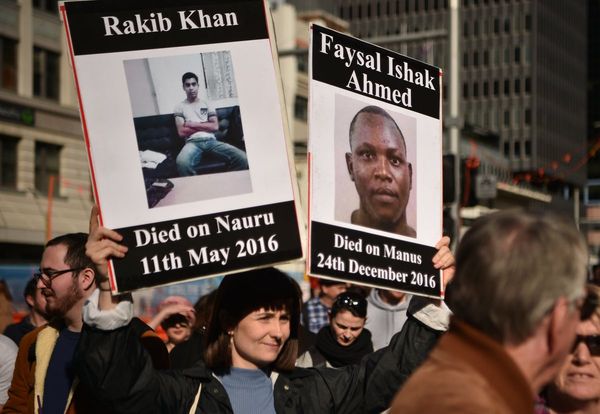
KABUL, Afghanistan—The one real advantage Afghanistan has had in its unrelenting war with the Taliban is in the air. With the withdrawal of U.S. forces though, Kabul is finding itself unprepared for the loss of the very air assets that, until now, have given it an edge over the insurgency.
The planned withdrawal of all U.S. troops and private contractors by Sept. 11—and the drawdown is already more than half complete—could leave the Afghan Air Force (AAF) grounded within months if the government does not find an alternative source of maintenance for its fleet of Black Hawk helicopters and C-130 Hercules transport planes. The last pilots trained in the United States to fly the A-29 Super Tucano light combat aircraft graduated in November 2020.
Losing the air arm would not only weaken ground forces but would also limit Kabul’s ability to carry out surveillance and reconnaissance missions over a resurgent Taliban—let alone shuffle troops and supplies around a mountainous country. That could see the battlefield balance change after the U.S.-NATO withdrawal following a hot summer of fighting that has seen an energized Taliban knocking over villages and districts across the country as they step up an undeclared offensive in the midst of the pullback.
For Afghanistan’s government, the change has come three years too early. A senior security official said AAF development had been planned through 2024 as part of a “decade of transformation” of the Afghan security forces, with U.S. and NATO support. It included the training of pilots, mechanics, and other relevant personnel; maintenance of aircraft and vehicles; and the establishment of maintenance facilities throughout the country.
Air support was “extremely critical for how [Afghan] forces fight,” the official said, speaking on condition of anonymity. “They are used to having close air support for most major offensives. They can do offensives without that. But the terrain in Afghanistan is very difficult, and the air force gave us an added advantage that we depend on. And now we will have to make adjustments.”
“Adjustments” probably means curtailing expectations. Having factored in U.S. support for the AAF for the next three years, the Afghan government had retired planes, pilots, and mechanics from its old Russian-built fleet, planning for a “total transition” to a new fleet provided by the United States and its NATO partners, the official said.
“Now that they are withdrawing and we are not going to receive the airframes from the Americans that we had planned for, we will have to keep some of the old fleet. It creates a challenge for us that we didn’t plan for,” the official said. “So we’re in uncharted territory when it comes to the conflict.”
And it comes amid a vicious Taliban offensive. Although the government does not release death and casualty figures and Taliban information is unreliable at best, security and political sources say hundreds of people are dying on both sides of the fight every month. The closure of madrassas, or Islamic religious schools, on the other side of the border in Pakistan provided the insurgents with an inflow of fighting-age men, one source involved in the peace effort said, speaking on condition of anonymity.
Despite “vast human resources,” the Taliban have been unable to take control of “territory that matters,” including provinces or even provincial capitals, despite hard-charging offensives in Helmand province, Kandahar, Ghazni, Laghman province, and elsewhere, the person said.
“The fact that they have not been able to make any significant attack in major cities, in Kabul or elsewhere, or they haven’t been able to take over a major city shows that the government is able to defend,” the source said.
U.S. President Joe Biden’s views on big military footprints overseas have been well known for a long time. Even so, Afghan security officials acknowledge they were taken by surprise at his decision to stick to the terms of the withdrawal brokered by his predecessor, former U.S. President Donald Trump. Only the deadline for the U.S. departure changed, from May 1 to Sept. 11.
The deal Trump reached with the Taliban, cutting out the Afghan government entirely, called for a halt to Taliban attacks on U.S. and international forces and a rupture with al Qaeda, in exchange for U.S. forces quitting the country. The Taliban have largely refrained from attacking U.S. forces but haven’t split with al Qaeda. But the United States is still getting out.
The Taliban have shown in the past that the government’s air capabilities present a serious threat. In September 2012, a Taliban attack on what was then known as Camp Bastion, in Helmand province, destroyed six $30 million AV-8B Harrier strike jets and damaged two others.
The most immediate problem is private contractors are leaving alongside the U.S. troops—and contractors are the ones who keep the AAF in the air. The AAF reportedly has around 143 aircraft and helicopters in service, with contractors providing maintenance for all but 13 Russian Mi-17 choppers, which the senior security official said are being retired, along with pilots, mechanics, and other support staff trained to work with them.
According to the Special Inspector General for Afghanistan Reconstruction (SIGAR), all maintenance of the AAF’s Black Hawk helicopters and C-130 Hercules transport planes, as well as a “significant share” of its light combat support aircraft, is carried out by contractors. No announcement has been made about whether or not contracts will be renewed to ensure ongoing support to the AAF.
In a recent report, SIGAR called contractor support a “critical” need, without which “none of the AAF’s airframe … can be sustained as combat effective for more than a few months.”
The head of U.S. Central Command, Gen. Kenneth McKenzie Jr., told the Senate Armed Services Committee in April, “I am concerned about the ability of the Afghan military to hold on after we leave, the ability of the Afghan Air Force to fly, in particular, after we remove the support for those aircraft.”
McKenzie told VOA the United States will not offer air support for Afghan ground forces in the future but will try to assist in keeping the AAF airborne by flying in spare parts and offering advice. Future U.S. and NATO support to Afghanistan was on the agenda for the NATO summit in Brussels on Monday.
One alternative is to offer “over the horizon” air support; although the United States has yet to find a neighboring country willing to host a military base that could enable timely air support to Afghanistan’s fighting forces. Washington does not have basing agreements with Pakistan, Iran, China, or the Central Asian states that fall into Russia’s sphere of influence, though some Afghan officials believe Uzbekistan remains an outside possibility.
“What we are looking for is the ability to shorten the legs going forward by stationing some capability in neighboring countries. That is still a work in progress,” said Secretary of Defense Lloyd Austin last week.
“We continue to provide support to the Afghan security forces as we retrograde,” he added. “Once we have completed our retrograde, that will be very difficult to do because our capabilities will have diminished in-country.”







